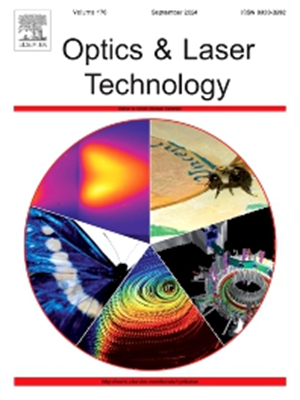Nondestructive characterization of nano-sized absorbing defects within laser devices using Atomic Force Microscopy-based Infrared Spectroscopy (AFM-IR)
IF 5
2区 物理与天体物理
Q1 OPTICS
引用次数: 0
Abstract
Currently, the application of micro-nanostructures has gradually expanded into the field of high-power lasers due to their unique advantages. However, absorbing defects introduced in the fabrication process have negative effects on the laser induced damage threshold (LIDT) and overall device performance. Research on characterizing nano-sized absorbing defects remains scarce due to various constraints. In this study, nano-sized polymethyl methacrylate (PMMA) and polystyrene (PS) particles were chosen to simulate nano-sized absorbing defects. Their distributions and compositions were successfully characterized using Atomic Force Microscopy-based Infrared Spectroscopy (AFM-IR) with a high resolution of approximately 7.1 nm. Absorbing defects as small as 50 nm have been characterized, and different substances can be identified in the same region. Additionally, we calculated the local absorption coefficients for the samples. The study confirms the feasibility of AFM-IR for characterizing nano-sized absorbing defects. This technology will facilitate more effective study and control of defects, thereby promoting the performance optimization of micro-nanostructures and high-power laser devices.
基于原子力显微镜的红外光谱(AFM-IR)无损表征激光器件内纳米级吸收缺陷
目前,微纳结构因其独特的优势已逐渐扩展到高功率激光器领域。然而,制造过程中引入的吸收缺陷会对激光诱导损伤阈值(LIDT)和整体器件性能产生负面影响。由于各种限制,有关纳米级吸收缺陷的表征研究仍然很少。本研究选择了纳米级聚甲基丙烯酸甲酯(PMMA)和聚苯乙烯(PS)颗粒来模拟纳米级吸收缺陷。使用基于原子力显微镜的红外光谱(AFM-IR)技术成功地对它们的分布和组成进行了表征,分辨率高达约 7.1 nm。对小至 50 纳米的吸收缺陷进行了表征,并可在同一区域识别出不同的物质。此外,我们还计算了样品的局部吸收系数。这项研究证实了利用原子力显微镜-红外技术表征纳米级吸收缺陷的可行性。这项技术将有助于更有效地研究和控制缺陷,从而促进微纳结构和高功率激光设备的性能优化。
本文章由计算机程序翻译,如有差异,请以英文原文为准。
求助全文
约1分钟内获得全文
求助全文
来源期刊
CiteScore
8.50
自引率
10.00%
发文量
1060
审稿时长
3.4 months
期刊介绍:
Optics & Laser Technology aims to provide a vehicle for the publication of a broad range of high quality research and review papers in those fields of scientific and engineering research appertaining to the development and application of the technology of optics and lasers. Papers describing original work in these areas are submitted to rigorous refereeing prior to acceptance for publication.
The scope of Optics & Laser Technology encompasses, but is not restricted to, the following areas:
•development in all types of lasers
•developments in optoelectronic devices and photonics
•developments in new photonics and optical concepts
•developments in conventional optics, optical instruments and components
•techniques of optical metrology, including interferometry and optical fibre sensors
•LIDAR and other non-contact optical measurement techniques, including optical methods in heat and fluid flow
•applications of lasers to materials processing, optical NDT display (including holography) and optical communication
•research and development in the field of laser safety including studies of hazards resulting from the applications of lasers (laser safety, hazards of laser fume)
•developments in optical computing and optical information processing
•developments in new optical materials
•developments in new optical characterization methods and techniques
•developments in quantum optics
•developments in light assisted micro and nanofabrication methods and techniques
•developments in nanophotonics and biophotonics
•developments in imaging processing and systems

 求助内容:
求助内容: 应助结果提醒方式:
应助结果提醒方式:


